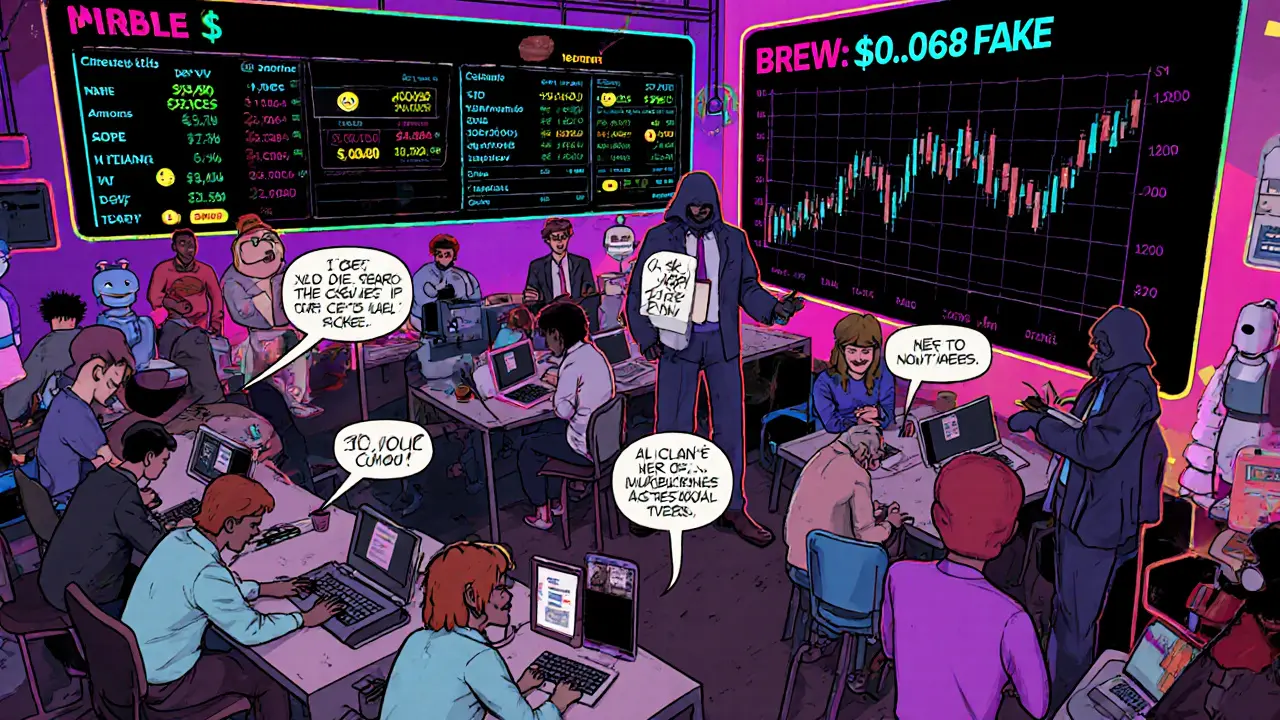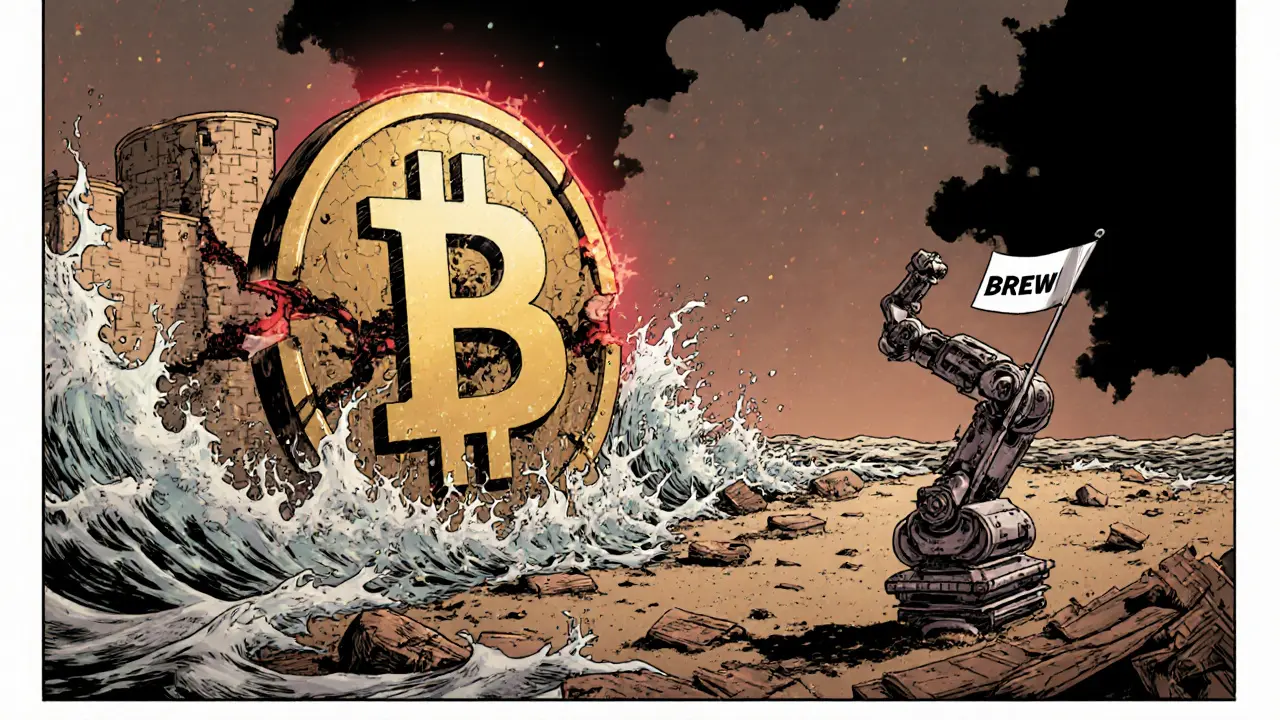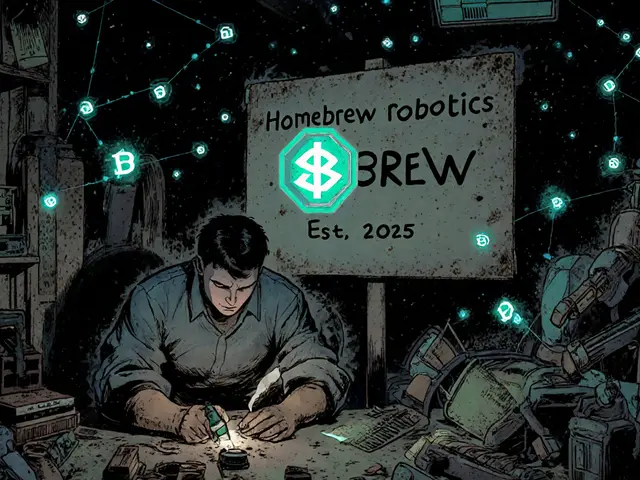Homebrew Robotics Club, or BREW, isn’t a company. It’s not a robot. It’s not even a product you can buy in a store. It’s a cryptocurrency token built on the Solana blockchain, and it’s trying to be something bigger: a community for hobbyists who build robots. But here’s the problem - most people who buy BREW aren’t building robots. They’re betting on price swings.
What BREW Actually Is (And Isn’t)
BREW stands for Homebrew Robotics Club. The name borrows from the original Homebrew Computer Club, a group of tech pioneers in the 1970s that included Steve Wozniak. That’s where the appeal starts - nostalgia for the early days of personal computing, when people built machines in garages, not boardrooms. The token’s website, homebrew.build, leans into this story. But unlike the original club, BREW has no physical meetings, no workshops, and no official hardware. It’s just a digital token with a story.
It runs on Solana, which means transactions are fast and cheap - around $0.00025 per trade. That’s a big reason why it exists at all. On Ethereum, a token like this would cost more in gas fees than most people spend on coffee in a month. Solana made it possible for small-time creators to launch community tokens without needing millions in funding.
There are nearly 1 billion BREW tokens total. About 80% are already in circulation. That’s a lot of tokens floating around, but not many people own them. Only 2,260 wallets hold BREW, and the top 10 wallets control over 43% of the supply. That’s not decentralized. That’s concentrated. And when a few wallets move, the price goes wild.
Where You Can Buy BREW (And Where You Can’t)
You won’t find BREW on Binance, Coinbase, or Kraken. It’s not listed on any major exchange. That’s not a glitch - it’s by design. BREW lives entirely on decentralized exchanges (DEXs) like Raydium and Jupiter, both built on Solana. To buy it, you need a Solana wallet like Phantom or Slope. You’ll need SOL to pay for the transaction, then swap it for BREW.
It’s not hard, but it’s not beginner-friendly. The whole process takes about 12 minutes if you’ve never used a DEX before. And even then, you’re not safe. There are fake websites, fake Discord accounts, and fake Telegram groups pretending to be the official BREW team. Solana Fraud Alerts warned users in October 2025 that impersonators are actively tricking new buyers into sending funds to the wrong addresses.
And when you do buy it, expect slippage. Because there’s not enough liquidity, your trade might execute at a price 4% worse than what you saw. That’s normal for small tokens, but it eats into profits fast. One user on Reddit reported buying BREW at $0.004 and selling at $0.0042 - only to realize the actual execution price was $0.0038 after slippage and fees.
Price Chaos and Why It’s So Unstable
Look up BREW’s price on CoinGecko, CoinMarketCap, and Liquidity Finder, and you’ll get three different numbers. CoinGecko says $0.0033. CoinMarketCap says $0.0031. Liquidity Finder says $0.0068. That’s a 134% difference. Why? Because no single exchange has enough buyers and sellers to set a real market price.
This isn’t just confusing - it’s dangerous. When a token’s price jumps 75% in 24 hours on one site but drops 7% on another, it’s not a trend. It’s manipulation. Low liquidity + high volatility = easy targets for whale traders. The all-time high was $0.01 in September 2025. By mid-October, it had fallen over 68%. That’s not a correction. That’s a crash.
Even the market cap numbers don’t match. One source says $2.99 million. Another says $3.58 million. The truth? The real value of BREW is probably closer to $2 million - if that. Most of the numbers you see are inflated by bots and wash trading. A 2025 report by The Block found that 60% of trading volume on low-cap Solana tokens like BREW comes from self-trading accounts.

Does BREW Have Any Real Use?
The project claims it wants to support open-source robotics. It says it wants to make hardware affordable and software free. But where’s the proof?
There’s no whitepaper. No technical roadmap. No funding plan. The GitHub repo has a single update from October 2025: a ‘Project Showcase’ page. Only 17 robotics projects were submitted in the first three days. That’s not a movement. That’s a footnote.
The team announced a partnership with InMoov, a well-known open-source robotics platform. But InMoov’s founder responded on Twitter with a neutral comment: ‘We’re aware of the project.’ No collaboration details. No joint development. No funding. Just a name drop.
And yet, the token is labeled as a DePIN (Decentralized Physical Infrastructure Network) project. That’s a buzzword for tokens tied to real-world hardware - like Wi-Fi hotspots or solar panels. BREW has none of that. Messari’s analyst David Park called it ‘marketing fluff.’ There’s no physical infrastructure. No sensors. No devices. Just a token and a Discord server.
The Community: Where the Real Value Might Be
Here’s the twist: the only thing keeping BREW alive is its Discord community. With over 8,300 members, it’s one of the most active crypto groups that isn’t purely focused on price.
People share CAD files for robot arms. They post videos of DIY battery packs. They troubleshoot Arduino code. One user, u/HardwareHobbyist, got 217 upvotes for saying: ‘The Discord community actually shares useful robotics project guides unlike most crypto groups.’
That’s the only real value BREW offers. Not as a coin. Not as an investment. But as a forum for people who love building robots. The token is just the entry ticket. If you care about robotics, you might find value here. If you care about making money, you’re in the wrong place.

Is BREW a Scam?
No. It’s not a scam. There’s no evidence the team is stealing funds or running a Ponzi. The website is real. The Discord is real. The GitHub commits are real. But it’s also not what it claims to be.
It’s a meme coin with a backstory. A community token dressed up as a movement. It’s riding the wave of Solana’s meme coin boom, the DePIN trend, and the hype around AI and robotics. But without funding, without utility, without a clear plan, it’s a house built on sand.
CryptoSlate’s analyst Maria Chen put it bluntly: ‘BREW operates in a crowded niche of community tokens with minimal differentiation from other Solana meme coins.’
And that’s the truth. There are hundreds of Solana tokens like this - each with a fun name, a vague mission, and zero real product. BREW’s only edge is the Homebrew Computer Club legacy. But nostalgia doesn’t pay bills. Code does.
What Happens Next?
The team says they’re planning community-funded hardware grants in Q1 2026 and a decentralized robotics design repository by Q3 2026. Sounds good. But where’s the money coming from? No treasury is listed. No funding mechanism is explained.
Forbes quoted blockchain researcher Dr. Alan Liu: ‘Without concrete utility beyond community tokenomics, BREW faces a 70% probability of becoming illiquid within 18 months.’
That’s the real question. Will BREW ever become more than a Discord group with a token? Or will it fade like every other Solana meme coin that peaked in 2024 and vanished by 2025?
The answer depends on one thing: whether the community can turn passion into progress. If people start building real robots funded by BREW - and those robots get used, shared, improved - then maybe it has a chance. If not? Then BREW will join the graveyard of tokens that looked cool on paper but never worked in the real world.
Should You Buy BREW?
Only if you’re okay with losing your money.
If you’re a robotics hobbyist who loves tinkering, join the Discord. Learn from others. Share your builds. Don’t buy BREW to get rich. Buy it to be part of the group - and treat it like a membership fee, not an investment.
If you’re looking to make money? Walk away. The risks are too high, the utility is too low, and the price is too unpredictable. There are better ways to invest in robotics - like buying stocks in companies that actually make robots. Or even better - build your own.
Is BREW coin a good investment?
No, BREW is not a good investment. It has no clear utility, no funding roadmap, and extreme price volatility. Its market cap is tiny, and a small number of wallets control most of the supply. Most trading volume is likely artificial. If you buy BREW, you’re betting on hype, not value. The probability of losing your money is high.
Can I use BREW to buy robotics hardware?
No. There is no official store, marketplace, or vendor that accepts BREW for hardware. While the project claims to support affordable robotics, no tangible system exists to turn BREW into physical parts. Any claims otherwise are likely scams or misleading rumors.
Is BREW listed on Binance or Coinbase?
No. BREW is not listed on any major centralized exchange, including Binance, Coinbase, or Kraken. It can only be traded on Solana-based decentralized exchanges like Raydium and Jupiter. This limits access and increases risk for new users.
What wallet do I need to hold BREW?
You need a Solana-compatible wallet like Phantom, Slope, or Solflare. BREW is an SPL token, which means it only works on the Solana blockchain. You’ll also need some SOL to pay for transaction fees when buying or transferring BREW.
Why is BREW labeled as a DePIN token?
BREW is labeled as a DePIN (Decentralized Physical Infrastructure Network) token by some platforms, but this is misleading. DePIN tokens are supposed to back real-world infrastructure like sensors, Wi-Fi nodes, or energy grids. BREW has no physical hardware, no sensors, and no verified infrastructure. Experts call this a marketing tactic, not a legitimate classification.
How can I tell if a BREW website or Discord is real?
Only trust the official website: homebrew.build/en. The official Discord is linked there. Never click links from Twitter, Telegram, or YouTube ads. Fake websites and impersonators are common. Check the contract address: 2hXQn7nJbh2XFTxvtyKb5mKfnScuoiC1Sm8rnWydpump. Any other address is a scam.
Does BREW have a whitepaper or technical documentation?
No. BREW has no whitepaper, no technical roadmap, and no detailed documentation. The website only has basic announcements and community links. This lack of transparency is a major red flag for crypto analysts and is one reason why it’s rated as high-risk by CoinGecko.
What’s the difference between BREW and RobotEra or Machi X?
RobotEra (TERA) and Machi X (MACHI) are larger robotics-themed tokens with more developed ecosystems - including virtual worlds, NFT robots, and in-game economies. BREW has none of that. It’s smaller, less funded, and lacks any game or platform. BREW’s only differentiator is its historical branding, not its product.
If you’re drawn to BREW because you love robotics, go to the Discord. Talk to builders. Share your work. That’s where the real value is. The token? That’s just noise.



Louise Watson
November 6 2025BREW is just nostalgia wrapped in a token. People miss the garage days. But nostalgia doesn't build robots.
Benjamin Jackson
November 6 2025I joined the Discord just to see what was up. Ended up helping a guy debug his servo code. Best part of my week. The coin? Meh. The people? Gold.
Kyung-Ran Koh
November 6 2025The fact that people still think this is a DePIN project is terrifying. There's no physical infrastructure. None. Zero. Nada. Just a Discord server and a contract address. Please stop using buzzwords you don't understand.
Michelle Stockman
November 6 2025So... it's a meme coin pretending to be a movement? And people are surprised it's crashing? 🤡
Liam Workman
November 7 2025I love how the only real utility here is the community. People sharing CAD files, troubleshooting Arduino, helping each other. That’s the heart of it. The token? Just the digital handshake. Like a t-shirt that says ‘I build stuff.’ Doesn’t mean you’re an engineer. But you might be.
Colin Byrne
November 8 2025Let me be blunt: this isn’t a project. It’s a liquidity trap disguised as a passion. The top 10 wallets holding 43%? That’s not decentralization-that’s a cartel. And the fact that people are still buying it because ‘the community is great’ shows how deeply crypto has rotting the ability to distinguish between value and vibes. You don’t fund innovation with a token that has no treasury, no roadmap, and no accountability. You fund it with capital, sweat, and deadlines. This has none of it.
Tara R
November 9 2025If you think this has any real-world impact you’re delusional. The only thing being decentralized is the delusion. No whitepaper. No funding. No hardware. Just a Discord server full of people who think buying a token makes them a roboticist. I’ve seen more legitimate innovation in a high school robotics club.
Brian Webb
November 10 2025I’ve been in this Discord for six months. I’ve seen people go from ‘I don’t know how to solder’ to building a full robotic arm with 3D-printed parts. That’s real. The coin? I bought $20 worth. I treat it like a club membership. I don’t expect returns. I expect community. And honestly? That’s more than most crypto projects give you.
Missy Simpson
November 11 2025i just wanna say thank you to the guy who shared that stepper motor wiring guide 🙏 i was stuck for 3 days and your post saved me. also i bought 5000 brew because i believe in the vibe lol
John Doe
November 13 2025This is all a Fed-backed pump. They need to kill DePIN narratives so they can push CBDCs. The ‘community’ is just a honeypot. Watch how fast it dies when Solana goes down. They’re all connected. You think this is about robots? No. It’s about control. And you’re the product.
Matthew Gonzalez
November 15 2025The Homebrew Computer Club didn’t have a token. They had schematics, soldering irons, and a shared basement. BREW has a Discord and a contract. One built computers. The other just built hype.
Whitney Fleras
November 16 2025I don’t care about the price. I care that I learned how to calibrate a servo from someone in Canada. That’s the real win. The token is just the gateway drug to actual tinkering.
Leo Lanham
November 16 2025You people are so naive. You think this is about robots? Nah. It’s about getting rich off the next guy who doesn’t know the difference between a DEX and a vending machine. The community? A distraction. A feel-good cover for a rug pull waiting to happen.
Kevin Mann
November 17 2025Okay, let me just say this: I’ve been building robots since I was 14. I’ve done 12 projects, sold 3 on Etsy, and yes-I bought BREW. Not because I thought it’d moon. But because the Discord is the only place where someone actually replied to my question about PID tuning in 12 minutes. Not days. Not weeks. 12 minutes. That’s worth more than any coin. I’m not here to flip. I’m here to learn. And if the token dies tomorrow? I still got the knowledge. And the friends. That’s the real ROI.
Rob Ashton
November 18 2025The fact that you’re even debating whether this is a scam shows how far we’ve fallen. It’s not a scam. It’s a failed experiment. And that’s okay. Not every community needs to be a business. Sometimes, it’s enough to just be a gathering of people who love building things. The token is irrelevant. The Discord? That’s the legacy.
Cierra Ivery
November 19 2025Wait, so you’re telling me that a token with no utility, no treasury, and zero real partnerships is being called a ‘movement’? And people are defending it because ‘the Discord is nice’? That’s not a movement. That’s a hobby group with a wallet. And the fact that you’re calling it ‘real value’ is the exact reason crypto keeps failing.
Veeramani maran
November 20 2025i buy brew because my friend from india said it will be big. he know coding. i dont know. but i trust him. also i like the robot pictures in discord
Ryan Inouye
November 21 2025Canada and the US are letting this trash become a ‘movement’? This is why our tech leadership is crumbling. You don’t build the future with memes and Discord servers. You build it with engineering, funding, and accountability. This is a joke dressed in open-source clothing.
Matthew Gonzalez
November 21 2025I think the most honest thing here is that BREW is a mirror. It reflects what crypto has become: a place where passion is monetized, community is commodified, and meaning is replaced with market cap. The token’s value isn’t in the coin. It’s in the fact that someone, somewhere, is still building things for the joy of it-even if the world insists on putting a price tag on everything.